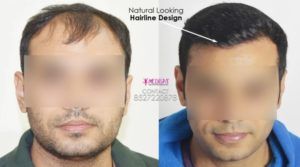
The origins of surgical practice in India can be traced back to 600 BC, when Sushruta, a trailblazer in the discipline, conducted the first recorded plastic surgery in the world. Since that time, India has cultivated a number of outstanding surgeons who have made notable advancements across various surgical fields. Beyond technical proficiency, a vital quality for a cosmetic surgeon is their artistic ability. A surgeon endowed with artistic skills can produce extraordinary outcomes, as cosmetic procedures require meticulous precision, keen attention to detail, and a creative mindset. The demand for hair transplants in Delhi has surged, influenced by factors such as an evolving cosmopolitan lifestyle, environmental pollution, the prevalence of processed foods, increased disposable incomes, and heightened awareness of hair restoration options. Furthermore, the hair transplant cost in Delhi remains reasonable, with top-tier facilities available at esteemed clinics. Consequently, Delhi has emerged as a key hub for medical tourism, drawing international patients in search of hair transplant services.
Dr. Suneet Soni, the head of Medispa hair transplant clinic, is an exceptionally talented surgeon distinguished by his unique artistic perspective. His remarkable surgical expertise, paired with a creative approach, has consistently yielded impressive outcomes in hair transplant procedures in Delhi, particularly in the crafting of flawlessly designed hairlines. With more than 10,000 successful surgeries to his credit and numerous positive patient testimonials, Dr. Soni is undoubtedly a leading figure in his profession. The pricing for hair transplant in Delhi is notably reasonable, ranging from INR 60,000 to INR 400,000, influenced by factors such as hair density, technique employed, and the degree of baldness. Medispa hair transplant clinic is recognized as one of the foremost clinics in Delhi, celebrated worldwide for its steadfast dedication to quality. This esteemed reputation has drawn a considerable number of international patients in search of exceptional care.
Basic process of hair transplant
The hair transplant procedure is a sophisticated, minimally invasive surgical technique that involves the extraction of hair follicles from a predetermined area of the body and their subsequent implantation into the target site. Only those hair follicles that are classified as permanent are selected for the procedure, usually sourced from specific regions such as the back and sides of the scalp, the chest, the armpits, and the beard. These permanent follicles guarantee enduring hair growth, leading to a natural look following the transplantation.
Phases of hair transplant process
It is important for you to be acquainted with the fundamental technique of hair transplantation; therefore, a comprehensive understanding of the procedure’s intricacies is crucial. In the following section, we will explore the hair transplantation process in detail. The procedure encompasses multiple stages.
- Planning: The first phase involves customizing the operation to meet the specific needs of each patient. This planning process takes into account the degree of hair loss, the density of hair in the donor region, and the patient’s desired results. After finalizing the planning, laboratory tests are performed to ensure the patient’s medical eligibility.
- Extraction phase: The initial stage of the extraction or harvesting process involves marking a preliminary hairline. Subsequently, hair follicles are extracted from the designated donor area utilizing FUT and FUE hair transplant methods. The selection of the appropriate hair transplant technique is influenced by various factors, including the location and severity of baldness, the desired hair density, and the preferences of the patient.
- Slitting phase: In the slitting phase, the recipient site is meticulously prepared in accordance with the established hairline design. It is crucial to ensure the correct angulation and arrangement to achieve a natural appearance in the hair transplant.
- Transplantation phase: During the hair transplant procedure, the harvested hair follicles are meticulously inserted into the incisions created by the surgeon. A team of highly skilled professionals employs magnification tools to guarantee the accurate placement of the hair follicles. The entire procedure is conducted with meticulous attention to detail, prioritizing the aesthetic objectives of the patient.
The length of a hair transplant procedure typically ranges from 4 to 9 hours, influenced by the surgeon’s skill and the degree of hair loss. In instances of significant baldness, several sessions may be required to attain the desired outcome. It is essential to select a physician who has received advanced training and has substantial experience in hair transplant surgery. Choosing a reputable clinic with a qualified surgeon is a critical factor in ensuring a successful procedure. For a reliable and remarkable hair transplant experience, consider arranging a consultation at the Medispa hair transplant clinic located in Delhi or Jaipur.
Methods to perform hair transplant
There are two primary techniques for conducting hair transplants: FUT and FUE. The FUT method, commonly known as the strip technique, involves the excision of a narrow strip from the donor area. This strip is subsequently divided into smaller segments, and each hair follicle is meticulously harvested under high magnification. After the donor site is sutured, the harvested follicles are carefully transplanted into the targeted bald areas. Conversely, the FUE technique entails the individual extraction of hair follicles using a punch-shaped instrument. This device is inserted into the skin to extract each follicle, which is then transplanted into the desired bald regions. The FUT method can yield approximately 3,000 to 3,500 hair follicles and is typically recommended for individuals with advanced baldness. In contrast, the FUE method can extract around 2,000 to 2,500 hair follicles and is generally suited for those experiencing early stages of baldness or for facial hair transplants.
Recovery after hair transplant
Many individuals express concern regarding the recovery process due to their busy schedules. However, there is no need for apprehension, as a hair transplant is considered a minor surgical procedure. You can certainly return to work the day following the procedure. It is possible to experience slight swelling on the forehead, accompanied by itching and mild discomfort. These side effects typically diminish within a few days’ post-transplant with minimal intervention. Full physical recovery can be anticipated within a timeframe of 7 to 10 days.
Hair growth after hair transplant
It is a common misconception to expect immediate results from a hair transplant. In reality, the transplanted hair requires time to grow, similar to natural hair. Typically, noticeable hair growth can be observed within 3 to 4 months’ post-procedure. By the six-month mark, the hair growth becomes significantly more apparent. Full hair growth is generally achieved approximately one year after the hair transplant.
Expectations from hair transplant procedure
Hair transplant is considered an elective procedure; however, it may not be suitable for everyone. A key factor that influences the viability of the hair transplant is the availability of hair follicles in the donor area. It is essential that the donor area possesses adequate density to ensure successful hair growth. The anticipated results are directly correlated with the number of hair follicles available for transplantation. It is crucial to have a preliminary discussion with your physician regarding your expectations for the hair transplant, as a thorough assessment will enable the doctor to provide insights into potential outcomes. If you have any questions or seek reliable information about hair transplants, we encourage you to visit Medispa clinic in Delhi or Jaipur for expert guidance and exceptional hair loss treatments.





